|
What is special about brass instruments?
By Ruoyan
The linking factor between all the traditional brass instruments (excluding
trombones) is that they have 3 (or occasionally 4) valves and that the
same combination of valves produce the same written note on each instrument.
This is not to say that each instrument produces the same physical note
in response to a given valve combination but that the combination of the
instrument's tuning and the key in which the music is written for any one
part allows the player to use the same valve combination for an 'A' on
both the cornet and the Eb Bass. Obviously this simplifies teaching and
the transfer from one instrument to another, indeed, many players will
happily change instruments at short notice to fill gaps in the band.

The Trumpet
A high member of the brass family, this wind instrument consists of
a shallow cupped mouthpiece at the end of a long metal tube looped once
and ending in a flared bell. Three valves on the top center of the modern
instrument are used to change the pitch resulting in a brilliant, penetrating
sound. In ancient Egypt it was used as a military instrument used for signaling
and fanfares. During the Renaissance and the Baroque era, trumpets were
used for musical purposes. Today, the trumpet is a standard instrument
in orchestras, bands, and many popular music ensembles. [Middle English
trumpette, from Old French trompette, diminutive of trompe, horn, from
Old High German trumpa.] |
The Cornet
is made from a conical bored brass tube about 4.5 feet
long and is tuned in the key of Bb. That is, when the note written as C
for piano is played it sounds as the Bb below (1 tone down). It differs
from the trumpet which has a more parallel bore of narrower tubing and
which produces a thinner and more strident sound than the mellow cornet.
The more obvious difference is that the trumpet is longer and less coiled
up than the cornet. In the middle of the cornet are three valves with plungers
operated by the first three fingers of the right hand.
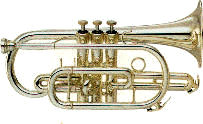 Each
of these valves changes the air path through the instrument and introduces
a slightly longer piece of tubing so lowering the tone of the note produced.
When the instrument is blown (by blowing a 'raspberry' into the mouthpiece)
without any valves pressed, it will produce a series of spaced notes dependent
upon the lip pressure used. These will correspond to the written notes
C, G, C, E, G, C etc. ascending.
-
The first valve from the mouthpiece end introduces a length of tubing which
lowers the note by one tone - that is, the note blown as C now plays as
Bb, G as F etc.
-
The second valve lowers the tone one semitone (half a tone) and so this
makes C, B natural, G becomes F sharp etc.
-
The third valve lowers the note by a tone and a half so making the C sound
as A, G as E etc.
|
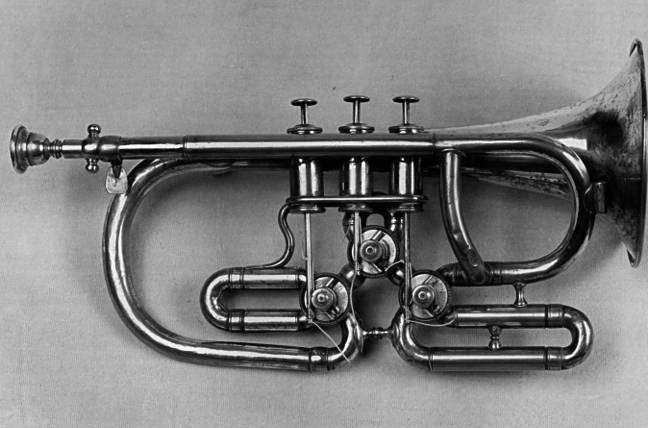
The Soprano Cornet
is the highest playing instrument in the band having less tubing than
the normal Cornet and plays in the key of Eb - that is the note written
as C for piano sounds as the Eb above. Some effort is required to play
the 'Sop' as it is usually known particularly as it often has high exposed
solo parts riding over the main melody. |
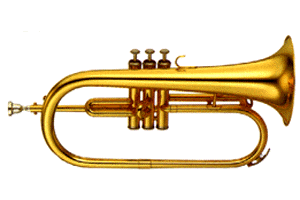
The Flugel Horn
looks like a large cornet and provides the link between the cornet and
horn sections. It is tuned in the key of Bb and has a beautiful mellow
tone which is best displayed in the haunting melody solos written typically
for this instrument.
|

The Tenor Horn
is the smallest of the tuba-like instruments in that its bell points
upwards when played instead if forward like a cornet. It is tuned in the
key of Eb and provides the musical filling between the melody and counter
melody in many pieces. It is also sometimes used as a solo instrument although,
as it is somewhat lacking in power, these tend to be romantic reflective
pieces where its mellow sound is supported by quiet chording from the rest
of the band. |
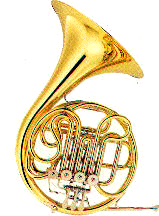
French Horn
A valved brass wind instrument that produces a mellow tone from a 21
foot long, narrow tube that is coiled in a elaborate circular structure
before ending in a flaring bell. In performance, French horn players place
their right hand inside the bell of the instrument to produce special
sound effects like muting. Because of its smooth tone color and expressive
ability to play both loudly and softly, it helps to blend the homogeneous
sound of the strings with the more varied color of the woodwinds. It evolved
from the hunting horn developed during the 17th century. The modern French
horn developed throughout the 19th century as valves were added to allow
players access to all the available notes.
|
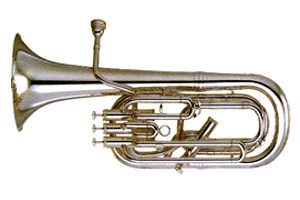
The Baritone (horn)
is slightly larger than the tenor horn, is tuned in the key of Bb, and
again mainly provides the filling or rhythmical parts of the music. |
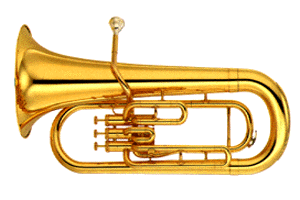
The Euphonium
is the second principal solo instrument of the band. Larger again than
the Baritone it is also tuned in Bb and is sometimes provided with a fourth
valve which duplicates the action of pressing valves 1+3 down but using
an additional length of tubing such as to give exact tuning in the lower
registers. This instrument is always on the go! Its parts often double
up the cornet melodies in a lower register whilst also providing the 'twiddly
bit' infill whilst the cornets are resting. At other times the Euphonium
plays a counter melody or helps out the Bass section.
|

The Trombones
are really the 'odd ones out' in the band. These instruments, of course
use a slide for tuning the different notes rather than valves and it is
for this reason -that they are not constrained to whole notes - that they
are included.Their strident glissandos are characteristic of many marches
and colourful pieces. The Bass Trombone is normally tuned in the key of
F and provides a link with the Bass section.
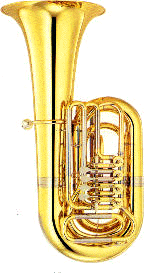
The Basses
are the large Tubas with which everyone is familiar. They come in two
varieties, Eb and BBb (double B flat) which are large and 'good God, do
you expect me to lift that?' respectively. They generally provide the background
'oompah' of the bass beat but also occasionally have quite moving passages
in the low register. They are not recommended to persons with small faces
as they may fall into the mouthpiece and disappear.
The lowest member of the brass family, tubas are valved to regulate
pitch and come in several sizes and shapes. Frequently associated with
the bass 'oom-pah' rhythm common to military and dance bands, tubas are
commonly used in both orchestras and bands and are capable of producing
a warm, rich, and powerful sound. An early ancestor to the Renaissance
serpent, the first modern tuba was patented i
| |




